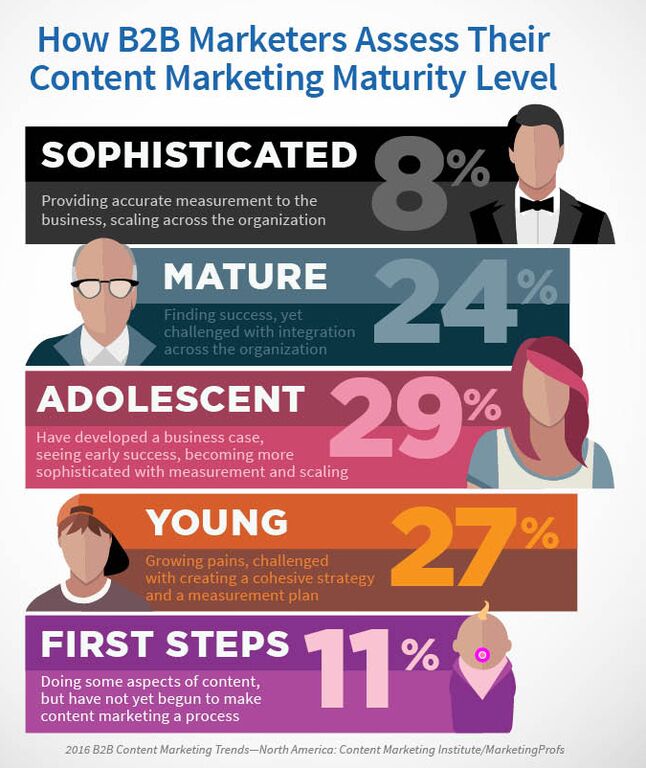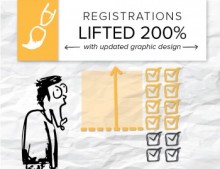In the Content Marketing Institute’s newly released annual State of B2B Content Marketing, it’s clear that despite the  perceived maturity of the industry, content marketing is still not a success story for all brands.
perceived maturity of the industry, content marketing is still not a success story for all brands.
The internet is content-saturated, with 88 percent of B2B brands using content for their marketing efforts. (In comparison, only 76 percent of B2Cs use content marketing.) Although not all brands are at the same maturity level in their overall content strategy lifecycle, the B2B marketing scene as a whole is split somewhat evenly:
- 8% are “sophisticated”
- 24% are “mature”
- 27% are “young”
- 29% are “adolescents”
-
11% are in their “first steps”
Here’s a recap of three surprising findings from the 2016 B2B marketing report:
B2Bs say content success has declined
The content scene might be more crowded, but success isn’t coming naturally to every brand. In fact, in comparison to last year, marketers are actually seeing less success. The problem outlined in the report is that most marketers aren’t sure the parameters of the success they’re striving for.
3 tips for more effective content:
Create an editorial mission statement.
![]() Right now, only 28 percent of marketers have an editorial mission statement that summarizes their goals and objectives for written content. When content is created with an end goal, a target audience and a mission statement in mind, it’s more likely to be collateral that’s serving a purpose, rather than something created blindly.
Right now, only 28 percent of marketers have an editorial mission statement that summarizes their goals and objectives for written content. When content is created with an end goal, a target audience and a mission statement in mind, it’s more likely to be collateral that’s serving a purpose, rather than something created blindly.
Collaborate for team meetings more.
![]() 44 percent say they currently discuss content marketing projects daily or weekly, but as more meetings occur, content effectiveness increases.
44 percent say they currently discuss content marketing projects daily or weekly, but as more meetings occur, content effectiveness increases.
Research noted, “61% of the most effective B2B marketers meet daily or weekly.”
Document.Your.Strategy.
![]() Last year Brafton reported that only one third of content marketing teams had a documented strategy. Despite this being a key factor to content effectiveness, the number of marketers with a documented strategy actually decreased from 35 to 32 percent this year. SO TO BE CLEAR: Marketers are taking steps BACKWARDS in this regard.
Last year Brafton reported that only one third of content marketing teams had a documented strategy. Despite this being a key factor to content effectiveness, the number of marketers with a documented strategy actually decreased from 35 to 32 percent this year. SO TO BE CLEAR: Marketers are taking steps BACKWARDS in this regard.
Visuals and illustrations see the biggest jump in usage
The power of visuals within a content marketing strategy shouldn’t be underestimated. We previously reported that 95 percent of marketers say it’s more effective than text-only content, and 9 percent say it’s 10 times more effective.
Statistics like these make it easy to understand why B2B brands using visuals and illustrations jumped from 69 to 76 percent in the past year.
Not sure how custom illustrations and photos could impact your content strategy? Check out this approach.
Here are 3 examples of B2B clients who see success with visuals:



Budgets correlate with content effectiveness
Despite marketers being unsure if their content is effective, decreasing budgets is not in the cards as a solution. Of those surveyed, only 3 percent plan to decrease their budget, and 51 percent say they will increase their 2016 spend on content.
When it comes to where marketers will invest content marketing efforts in 2016, Brafton previously reported that video will be a sweet spot, with 2 out of 3 marketers planning to invest more in the visual format. Marketing technology also is taking a front seat, with 60 percent planning to spend more in the next two years, and nearly 4 in 10 making a conscious effort to improve their tech knowledge.




